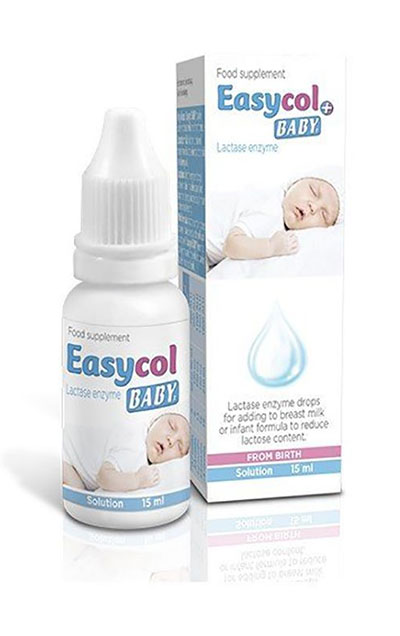
E ASYCOL BABY+®
ASYCOL BABY+®
WHAT IS LACTASE?
Lactase is a natural enzyme produced in the small intestine. It plays a crucial role in the hydrolysis of lactose, breaking it down into glucose and galactose, allowing its absorption in the body during digestion.
WHAT HAPPENS WHEN NOT ALL LACTOSE IS DIGESTED?
During the first months of life, some babies struggle to digest lactose in milk because part of it remains unhydrolyzed. This condition, which is relatively common and temporary, typically occurs in the first four months of life due to low production of endogenous lactase. As a result, some of the ingested lactose is not broken down and is instead fermented by intestinal bacteria. This leads to gas production, acidic diarrhea, bloating, discomfort, and prolonged crying episodes.
WHAT CAN BE DONE?
A recommended solution is lactase supplementation, which enhances the enzymatic breakdown of lactose. This helps improve milk digestion, relieve discomfort, and reduce excessive crying episodes.
WHAT IS EASYCOL BABY+®?
Easycol BABY+® is a lactase enzyme dietary supplement that acts solely on milk. It can be used with breast milk or infant formula to compensate for the temporary deficiency of lactase during the early months of life. Easycol BABY+® is a natural and safe solution that alleviates discomfort and excessive crying
HOW DOES EASYCOL BABY+® WORK?
Easycol BABY+® works by breaking down lactose in breast milk or infant formula into two simple sugars: glucose and galactose. This facilitates digestion and improves milk absorption.
Scientific studies have demonstrated that infants consuming milk treated with lactase show a significant reduction in crying duration due to improved digestion.
WHEN SHOULD EASYCOL BABY+® BE USED?
Easycol BABY+® is a safe product and can be used from the first day of life. Lactose digestion issues usually resolve naturally after four months, as the body increases lactase production. During this period, semi-solid foods are introduced into the infant’s diet (purees and soups), at which point Easycol BABY+® usage can be gradually reduced.
If discomfort reoccurs after reducing the dose, it is recommended to return to the previous dosage.
HOW TO USE EASYCOL BABY+®
Easycol BABY+® can be used with breast milk or infant formula.
With breast milk:
Expressed milk: Add the prescribed number of drops as per the dosage table and mix well.
Direct breastfeeding: Administer the prescribed number of drops using a small spoon before breastfeeding.
With formula:
Add the prescribed number of drops directly into the milk bottle and mix well.
Easycol BABY+® does not alter the taste of milk and can be added to both warm and cold milk.
If preparing a feeding bottle in advance, add 4 drops of Easycol BABY+® and store in the refrigerator for no longer than 4 hours.
DOSAGE TABLE
(If your baby experiences greater discomfort, you may gradually increase the dosage by adding one extra drop at a time, up to a maximum of 12 drops per meal.)
| Age | Milk Volume per Feedin | Drops per Meal | Lactase per Meal | Feedings per Day | Daily Intake |
| 0-2 sedmice | 60 to 90 mL | 5 kapi | 750 ALU | 6 | 4500 ALU |
| 3-4 sedmice | 120 mL | 6 kapi | 900 ALU | 6 | 5400 ALU |
| 1-2 mjeseca | 150 mL | 8 kapi | 1200 ALU | 5 | 6000 ALU |
| 3-4 mjeseca | 180 mL | 9 kapi | 1350 ALU | 5 | 6750 ALU |
| > 4 mjeseca | 210 mL | 12 kapi | 1800 ALU | 4 | 7200 ALU |
INGREDIENTS
Carriers: Glycerin, Water
Lactase enzyme (45000 ALU)
Stabilizer: Potassium chloride
Preservative: Potassium sorbate
IMPORTANT NOTES
– Do not exceed the recommended dosage.
– Dietary supplements are not a substitute for a balanced diet.
– It is important to maintain a balanced diet and a healthy lifestyle.
– This product should not be used in cases of hypersensitivity, allergies, or known interactions with any of its ingredients.
STORAGE INSTRUCTIONS
– Store in a cool and dry place, in its original packaging, at a temperature below 25°C.
– Keep away from light and heat.
– Keep out of reach and sight of children.
DISTRIBUTOR (EU)

Dr. Val Carreres Ortiz Street, No. 2, 50004 Zaragoza, Spain
Phone: (+34) 876 771 071
Reference: DJ Kanabar et al., “Reduction of colic symptoms in infants following lactose reduction with lactase enzyme.” Journal of Human Nutrition and Dietetics, 2001; 14: 359-363.
